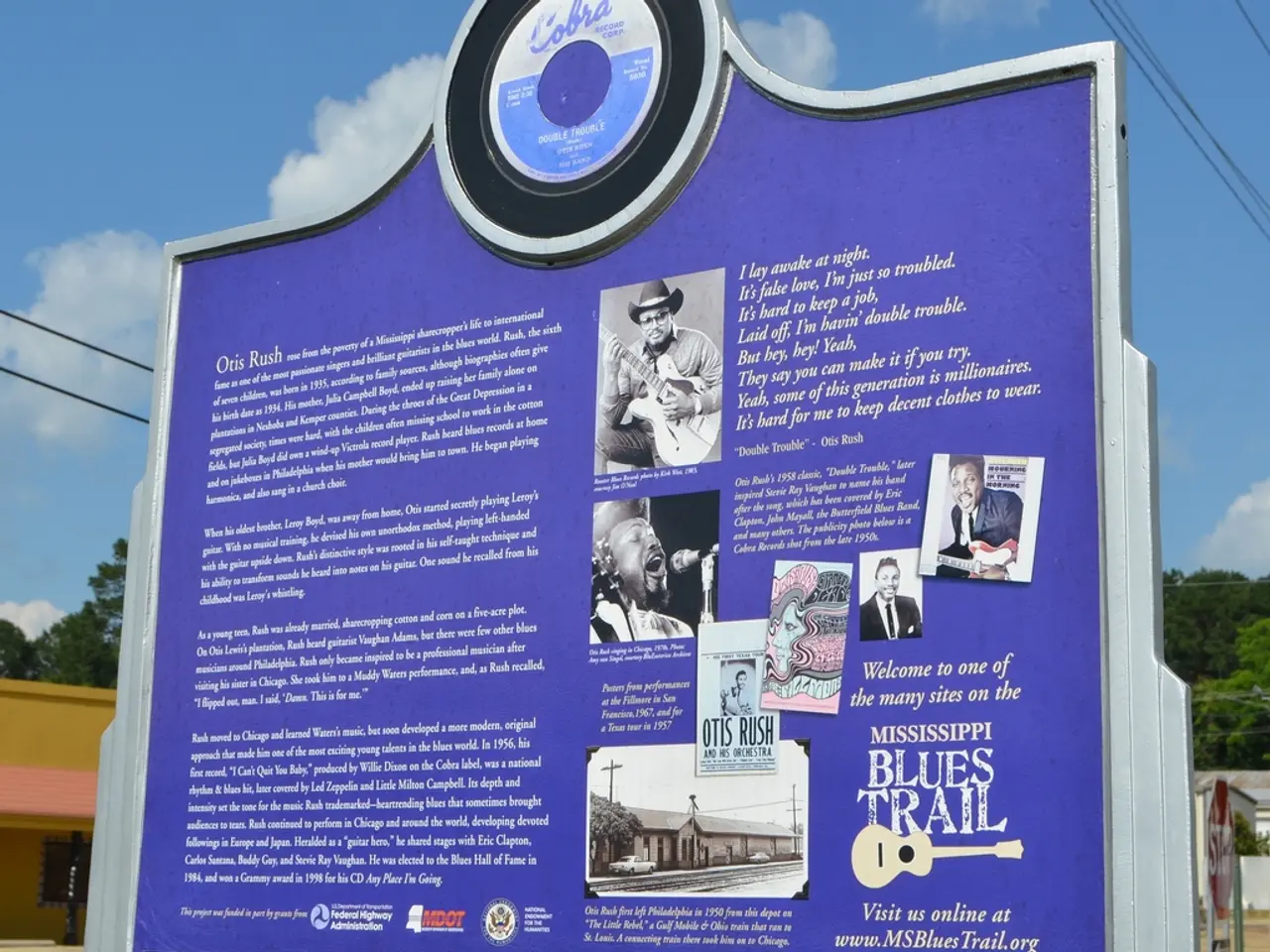Exploring the Intricacies of Guitar-based Rhythms and Harmonies in the Realm of Rock Tunes!
Unveiling the Enigmatic Art of Crafting Captivating Guitar-Driven Melodies in Rock Music
The fusion of lyrics and guitar-driven melodies in rock music is a powerful combination that stirs the soul and ignites the imagination. To create enigmatic and captivating guitar melodies, musicians should focus on using scales and tonalities that evoke mystery, such as the Dorian mode or blending major and minor pentatonic scales.
By limiting scale positions, creative constraints are imposed, helping ideas stand out. Harmonized intervals like 3rds and 6ths can add richness to the melodies, while experimenting with embellishments, phrasing, and rhythmic variations can transform simple melodies into compelling leads.
Unconventional chord progressions, such as mixing minor and major chords in non-traditional sequences, can build harmonic tension supporting the melody. Drawing inspiration from innovative rock guitarists like Wes Borland, who is known for wild, experimental sounds, can encourage musicians to experiment with tone and effects.
Studying the history of guitar experimentation, such as The Beatles' use of studio techniques like tape manipulation, layering, and incorporating nontraditional instruments, can inspire musicians to think beyond conventional guitar sounds and arrangements, adding an enigmatic quality to their music.
Practicing with deliberate imperfection can develop expressive phrasing and nuance, making melodies feel more human and emotionally captivating rather than overly polished. By combining these approaches—scale choice, harmonization, rhythmic creativity, unconventional progressions, and experimental tonal textures—musicians can produce guitar melodies in rock music that are both enigmatic and deeply engaging.
Understanding the psychology behind memorable guitar-driven melodies reveals a labyrinthine maze of emotions, memory triggers, and cognitive processes at play. Attending workshops, classes, or online tutorials can help improve guitar-playing skills, while exploring different scales and modes offers a range of emotions and atmospheres, unlocking their full potential when fashioning spellbinding guitar melodies.
Crafting melodies driven by the power of the guitar requires consideration of mood, message, and harmony with lyrics. From abrasive distortion to crisp arpeggios, the sonic landscapes painted by the guitar evoke emotions. Incorporating guitar solos into melodic compositions requires a delicate dance between raw skill and heartfelt storytelling.
The structure and arrangement of a guitar-driven melody play a significant role in how it is perceived by listeners, with strategically introduced elements of variation, tension, and resolution captivating audiences. Catchy riffs, intricate chord progressions, and awe-inspiring solos are used in guitar-driven melodies.
The impact of guitar-driven melodies on audience engagement is profound, with the ability to awaken emotions, resurrect forgotten recollections, and kindle fervor within listeners. The enigmatic interplay of dynamic range in rock music shapes the essence of guitar-driven melodies. Collaborating with bandmates can result in an explosion of innovation and enthralling harmonies in guitar-driven melodies.
Iconic guitar-driven melodies in rock music history include "Purple Haze" and "Whole Lotta Love." Melodies in rock music act as the core around which songs revolve. Guitar effects are not just tools but gateways to uncharted musical territories. Meticulously crafted guitar-driven melodies can elevate compositions to new heights, leaving a lasting impact on listeners.
Experimenting with different guitar effects opens up a world of sonic possibilities. These melodies work in harmony with drums and bass to create a vibrant musical landscape. Crafting guitar-driven melodies requires a blend of technical prowess and creative flair. Recording yourself playing regularly can help track progress and identify areas for improvement.
Techniques like palm muting, bending, vibrato, and tremolo picking add layers of texture and emotion to each note played. Dynamics in guitar-driven melodies include volume fluctuations, tonal shifts, and intensity variations. Distortion, delay, reverb, and wah-wah can transform melodies into enigmatic tapestries of sound. Delay adds ethereal ambiance to melodies, while distortion brings raw energy and intensity.
Collaborating with other musicians can push the boundaries of creativity and enhance guitar-playing skills. Lyrics have the power to inspire melodies that burst forth with passion and intensity. The guitar often leads in constructing these melodies. The symbiotic relationship between lyrics and guitar-driven melodies shapes the emotional impact of a rock song.
Delving into the labyrinth of chord progressions, scales, and arpeggios can unearth unique and enthralling melodies. The guitar-driven melodies in a song serve as the foundation for mood and emotional resonance. The tone and timbre of the guitar shape the mood of a composition in rock music. Arpeggios can be used to delineate chord progressions and add intricacy to guitar-driven melodies.
Achieving harmony between complexity and catchiness in guitar-driven melodies requires a delicate alchemy comprising equal parts skillful execution, boundless imagination, and an acute awareness of audience preferences. The future of guitar-driven melodies in rock music is a whirlwind of thrilling possibilities, with technological advancements paving the way for boundless experimentation and ingenuity.
Melodies convey mood and ambiance within a song, providing a foundation for lyrics to thrive. Technology, such as effects pedals, recording software, and virtual amp simulations, enhances guitar-driven melodies by providing access to an endless array of tones and effects. These elements intertwine to create a tapestry of sound that resonates deeply with listeners.
Legendary guitarists like Eric Clapton and David Gilmour showcase the profound impact of well-crafted melodies. A well-crafted melody can elevate the impact of a rock composition, adding depth and resonance. Seeking inspiration from other guitarists for melody creation can expand musical horizons and ignite fresh sparks of ingenuity for your own melodic compositions.
Guitarists use bending, tapping, and sliding techniques to infuse their melodies with a unique personality. Melodies captivate listeners and stir emotions, making them a fundamental element in creating powerful music. The guitar leads in constructing these melodies, injecting raw emotion and intensity into the heart of rock music.
- Understanding the music theory behind popular trends in music history, such as the use of the Dorian mode or blending scales, can aid musicians in creating enigmatic guitar melodies in rock music.
- Embellishments, phrasing, and rhythmic variations can be employed to transform simple melodies into compelling leads, contributing to the captivating nature of rock music.
- The impact of technology on music, including effects pedals, recording software, and virtual amp simulations, allows musicians to explore various sounds and tones, increasing the possibilities in crafting guitar-driven melodies.
- Collaborating with musicians from different fields, such as sports, entertainment, or other genres, can offer a fresh perspective and encourage experimentation in creating innovative and captivating guitar melodies.
- By fusing elements of blues, rock, and other genres within their compositions, musicians can capture the essence of music history while innovating a unique, enigmatic sound in their own music.




